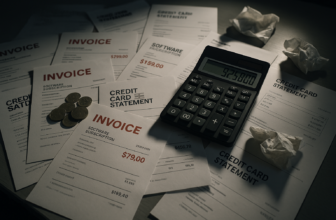Key Takeaways:
- Select software depending on your needs, budget, and business objectives.
- When accounting software is integrated with Etsy, time is saved, and accuracy is enhanced.
- Do not forget about sales tax, tracking expenses, and regular monitoring of finances.
- Etsy sellers require accounting software to facilitate and maintain financial management as well as tax compliance.
Accounting Software for the Etsy Sellers.
As an Etsy seller, you are not only a creative entrepreneur, but you also have to do Etsy bookkeeping, financial planning, and tax preparation. A lot of hats to wear! Investing in the best accounting software for Etsy sellers can help to make bookkeeping for Etsy much easier and quicker.
Using the right bookeeping for etsy, you will be able to:
- Easily track your income and expenses
- It is easy to monitor your income and expenses.
- Generate key financial reports
- Prepare for tax season
- Use data to make your business grow.
Manual bookkeeping for Etsy may appear to be possible in the beginning, but as your shop expands, it can be time-consuming and error-prone. Accounting software automates many processes, which will save you time and make sure that you get everything right.
Best Accounting Software for Etsy Bookeeping
Then, what is the best bookeeping for etsy sellers? Here are some of the leading candidates that can take the pressure off from bookkeeping and let you focus on your craft:
QuickBooks Online is an inclusive system that is natively connected to Etsy, which would be perfect for developing businesses. It has strong reporting, stock tracking, and multi-user support. However, it may be expensive and daunting to novices.
QuickBooks
Ideal for small to medium-sized Etsy sellers, freelancers, and growing e-commerce businesses needing scalable accounting solution
Rasons to buy
- + Automates data syncing from Etsy, saving time and reducing errors
- + Scalable plans support business growth.
Possible Drawbacks
- –Some advanced features require higher-tier plans
- –Higher pricing compared to alternatives
- ● Plans range from $35/month (Simple Start)
Wave is free, easy, and has a simple dashboard – ideal for new sellers with no money. The trade-off is that it does not have direct Etsy integration and some advanced options.
Wave
Wave is best suited for small business owners, freelancers, consultants, and Etsy sellers with tight budgets or basic financial management needs
Rasons to buy
- + Free accounting tools including invoicing, expense tracking, and receipt scanning
- + Multi-currency support for international sales
- + Mobile app for invoicing on-the-go
- + Option to hire professional bookkeepers for additional support
Possible Drawbacks
- –Limited integrations
- –Payroll features only available in the US and Canada
- ● Starter Plan: Free with essential accounting tools
Xero is famous for its powerful inventory management and customizable reports, Xero is good for sellers with more complex financial needs. It supports various currencies but advanced plans are expensive.
Xero
Small business owners, Etsy sellers, and rapidly growing e-commerce businesses needing efficient bookkeeping and financial management
Rasons to buy
- + Automated reconciliation of Etsy sales, fees, and taxes
- + Multi-currency support for international transactions
- + Detailed financial reporting with real-time insights
Possible Drawbacks
- –Limited payroll features in certain regions
- –No direct phone support
- ● Starter plan: $29/month (limited invoices/bills)
FreshBooks is easy to use and has excellent expense tracking, so it is a good option for Etsy sellers who are service-based. However, its inventory capabilities are poor.
Freshbooks
FreshBooks is best suited for small business owners, freelancers, and Etsy sellers with straightforward financial needs. It caters to those who prioritize ease of use and simplicity over advanced features like inventory trackingrnrnu0026nbsp;
Rasons to buy
- + User-friendly interface ideal for beginners
- + Easy expense tracking and invoicing
- + Generates tax-ready financial reports
- + Offers time-tracking for service-based sellers
Possible Drawbacks
- –Lacks robust inventory management features
- ● Lite Plan: $7/month
- ● Plus Plan: $13.20/month
How to Choose the Best Accounting Software for Etsy Sellers
In order to choose your ideal accounting software you must do the following:
How to Get Started with Accounting for Etsy
Are you ready to up your Etsy bookkeeping game? Follow these steps:
- Open a shop account with a separate bank account.
- Collect your Etsy sales reports, fee statements, etc.
- Select and install your accounting software.
- Record every business expense, no matter how small it is.
- Schedule some time each week for bookkeeping (I do 30 min a week)
- Sit down with a tax pro to get your setup optimized.
It is essential to keep your business and personal finances separate for clean records and simple tax prep. Believe me, your future self will thank you for it.
Common Mistakes in Accounting for Etsy (and How to Avoid Them)
Throughout the years, I have learned many Etsy accounting lessons the hard way. Some of the pitfalls that one should be on the lookout for include:
- Failing to monitor such things as office supplies purchases or costs of home office.
- Failure to comply with sales tax regulations in other states you are selling in.
- Mixing business and personal expenses
- Being late on bookkeeping and frantic at tax time
- Failure to reconcile accounts, which may conceal mistakes.
The best precaution is to keep a good record and review finances regularly. In doubt, ask a pro!
Tax Considerations for Etsy Sellers
Talking about taxes, they are one of the most important elements of Etsy accounting. Stay on top of:
- Sales tax in those states where you have nexus
- Deductions for business expenses
- Quarterly estimated tax payments
- Self-employment taxes
- Record retention requirements
Some accounting systems such as Xero have even been integrated with sales tax software to make compliance easier. The fact that you are Working with a tax advisor who is versed with the ecommerce can also give you peace of mind.
Frequently Asked Questions
Why do I need to have separate accounting software for my Etsy shop?
Although Etsy has basic financial reporting, there is more comprehensive expense tracking, tax prep, and inventory management tools through dedicated accounting software. It’s critical for running your shop as the real business it is!
How does the accounting software work with Etsy?
The best accounting software for Etsy sellers can automatically retrieve your sales, fees and tax information from Etsy. This eliminates tons of time and mistakes in manual entry.
Which characteristics of Etsy accounting software should I be most concerned about?
Must-haves are direct Etsy integration and expense tracking, as well as financial reporting. Depending on your shop, you may also need good inventory tools, multi-currency support or ability to track project profitability.
What Etsy accounting software can I afford?
Expect to spend $0-50+ per month. Free options such as Wave are good enough for basic requirements, but more expensive solutions provide greater functionality. After all, it’s a business tax-deductible expense!
Will free accounting software suffice for meeting my Etsy business needs?
It will depend on how complex your shop is and how developed it is. Wave and other free alternatives can be effective when one starts out. However, as you grow, paid programs provide more time-saving automation and reporting to drive big-picture decisions. It is an investment that can yield returns.
The secret to Etsy bookkeeping is to establish the right system before you’re being suffocated by receipts and reports. Leave the numbers to the accounting software and concentrate on the enjoyable part of it – delighting customers with your wonderful products!



